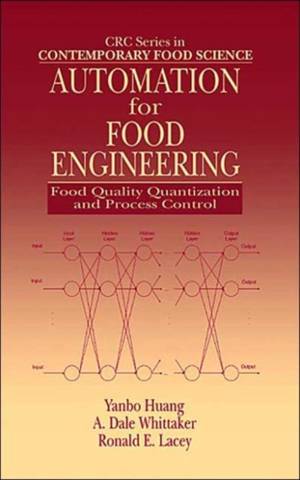
- Retrait gratuit dans votre magasin Club
- 7.000.000 titres dans notre catalogue
- Payer en toute sécurité
- Toujours un magasin près de chez vous
- Retrait gratuit dans votre magasin Club
- 7.000.000 titres dans notre catalogue
- Payer en toute sécurité
- Toujours un magasin près de chez vous
Automation for Food Engineering
Food Quality Quantization and Process Control
Yanbo Huang, A Dale Whittaker, Ronald E Lacey
534,45 €
+ 1068 points
Description
In the past ten years electronics and computer technologies have significantly pushed forward the progress of automation in the food industry. The application of these technologies to automation for food engineering will produce more nutritious, better quality, and safer items for consumers. Automation for Food Engineering: Food Quality Quantization and Process Control explores the usage of advanced methods, such as wavelet analysis and artificial neural networks, to automated food quality evaluation and process control. It introduces novel system prototypes, such as machine vision, elastography, and the electronic nose, for food quality measurement, analysis, and prediction.
The book discusses advanced techniques, such as medical imaging, mathematical analysis, and statistical modeling, which have proven successful in food engineering. The authors use the characteristics of food processes to describe concepts, and they employ data from food engineering applications to explain the methods. To aid in the comprehension of technical information, they provide real-world examples and case studies from food engineering projects. The material covers the frameworks, techniques, designs, algorithms, tests and implementation of data acquisition, analysis, modeling, prediction, and control in automation for food engineering. It demonstrates the techniques for automation of food engineering, and helps you in the development of techniques for your own applications. Automation for Food Engineering: Food Quality Quantization and Process Control is the first and only book that gives a systematical study and summary about concepts, principles, methods, and practices in food quality quantization and process control.Spécifications
Parties prenantes
- Auteur(s) :
- Editeur:
Contenu
- Nombre de pages :
- 240
- Langue:
- Anglais
- Collection :
Caractéristiques
- EAN:
- 9780849322303
- Date de parution :
- 28-06-01
- Format:
- Livre relié
- Format numérique:
- Genaaid
- Dimensions :
- 156 mm x 234 mm
- Poids :
- 512 g







